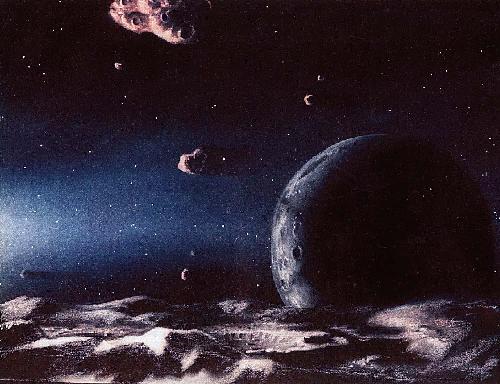 |
 |
|
| Comet | Jewitt | Kuiper |
|---|
| My Classes at UCLA |
|---|
Ge 70: Evolution of the Cosmos and Life
This is a three-term "cluster" class that allows mostly non-science students to satisfy numerous UCLA science and other requirements. The first term is about astrophysics related topics, the second more biological and the third self-directed into a sub-area. I co-taught this with Erik Petigura, Caitlin Brown and Tony Friscia, who runs the whole UCLA Cluster series (the other clusters are not science focused). We had to do it on-line.
Class size: 2020=230,
Sample Syllabus |
2020F Evaluations
|
2021W Evaluations
|
I'm set to teach it again in 2021.
EPSS 9: Solar System
This is an undergraduate class covering the science of the Solar
system. Avoiding the usual narrow focus on individual objects, we
discuss broad classes of objects and the processes behind them. The
class includes a laboratory component. Enrollment is
huge!
Class size: 2010=60,
2012S=120, 2012F=140, 2013F=220, 2016W=392:
Sample Syllabus |
2011W Evaluations
|
2012S Evaluations
|
2012F Evaluations
|
2013F Evaluations
|
2016W Evaluations
|
2020W Evaluations
|
Next offered ...unknown
|
EPSS 15: Introduction to Oceanography
Undergraduate class on the physics, chemistry and biology of the
oceans. Topics covered include the properties and distribution of the
oceans, their relation to geology and geophysics of the Earth, origins,
source and sinks of water, thermal and salinity-driven circulation,
ocean-atmosphere, climate change, carbonate-silicate cycle, oceans of
other worlds, life in the ocean, benthic & pelagic life, food systems,
phytoplankton, origin of life, commercial and military uses of the
oceans. The class includes a laboratory component. The aim
of the class is to show the true excitement of oceanography,
interpreted in its broadest sense.
Enrollment is
huge!
Class size: 2013S=360, 2015S=419, 2016S=416, 2018S=443, 2020S=460, Mondays and Wednesdays 1:00pm - 2:15pm in Moore 100
Sample Syllabus
|
2013S Evaluations
|
2015S Evaluations
|
2016S Evaluations
|
2018S Evaluations
|
2020S Evaluations
|
Next offered ...unknown
|
EPSS 19: Fiat Lux
Special, 10-hour class for 10 < n < 20 undergraduates, consisting of two
1 hour meetings in class and an 8 hour field trip to the NASA Jet Propulsion
Laboratory.
Class size: 2016S=20
>
|
2016S Evaluations
|
EPSS 200E: Planetary Origins
Graduate class emphasizing physics of planetary science. All blackboard derivations.
Class size: 2013F=5, Next offered ... TBD
Sample Syllabus
|
2013W Evaluations
|
EPSS 286A: Planetary Lunch
Weekly discussion of topical planetary science subjects by invited speakers. Typical
attendance is 20 people.
2009 and 2010.
Next offered....?
Because Planetary Lunch is not enough. iPLEX lunch
aims to be less formal, more interactive, and comes with pizza. Attendance is 20 to
30 people, often not the same ones as Planetary Lunch.
EPSS 264: Orders of Magnitude
Graduate, highly interactive class to encourage clear thinking about
physical problems. The class is described
here.
I limit the class size to about 7 to keep it interactive (except for one
occasion in which I broke my own rule and reminded myself that this was a
bad idea).
"It is the nature of all greatness not to be exact."
-Edmund Burke
Next offered...?
Description
|
2009A Evaluations
|
2009B Evaluations
|
2012A Evaluations
|
2012B Evaluations
|
2013W Evaluations
|
2014S Evaluations
|
2015W Evaluations
|
2017S Evaluations
|
2018W Evaluations
|
2019S Evaluations
|
EPSS 298: Hot Topics in Planetary Science
(Fall 2016): Graduate reading class covering hot topics in planetary science.
Description
|
2016W Evaluations
|
2019S Evaluations
My older
class page.
David Jewitt
iPLEX Lunch
 |
 |
|
| Comet | Jewitt | Kuiper |
|---|